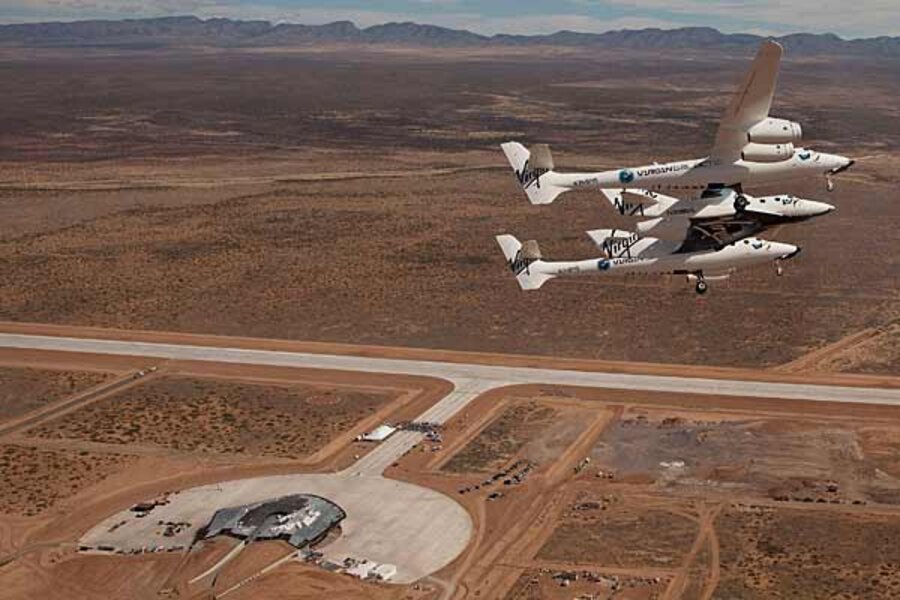Will space tourists be Earth polluters? Scientists sound a warning.
Scratching an expensive itch to take a pleasure trip to the doorstep of space might come with an unintended consequence: altering the climate back on Earth.
A new study suggests that projected increases in so-called suborbital flights – including space tourism launches – will boost the amount of soot in the stratosphere, measurably changing climate. The soot comes from hybrid rocket motors, which burn a rubbery solid fuel, aided by a gas "oxidizer" as a stand-in for oxygen. By contrast, many liquid-fueled rockets burn oxygen and hydrogen, which produces a cleaner exhaust.
According to the results, temperatures in the region around the launch site would likely cool slightly as the high-altitude soot blocked some sunlight. But the soot would spread around the globe, warming the stratosphere and touching off changes in its circulation that would bring additional warming to the poles.
Growing demand
If demand for suborbital flights grows to levels some in the industry project by 2020, black carbon's climate effect could rival the impact from soot coming from all the world's trains, trucks, and heavy construction equipment, the researchers calculate.
The study represents an initial look at the issue, cautions Martin Ross, a scientist at Aerospace Corp., an independent aerospace research firm in El Segundo, Calif., and the lead author on the research paper reporting the results. Many uncertainties remain, including the validity of traffic projections. And any potential effects, if they appear, are decades away.
"What we want to do is understand this now so nobody makes big investments in systems that are not sustainable in the long run," he says. New aerospace systems – from the US Air Force's aging B-52 bombers to NASA's space shuttle – take roughly 10 years to design and test and then remain in service for decades.
Some entrepreneurs already are making those investments. On Oct. 22, Richard Branson, the adventurer and founder of Virgin Atlantic Airways, among other enterprises, welcomed the space-tourism venture Virgin Galactic's first spaceship to its spaceport near Upham, N.M. The craft, SpaceShipTwo, was delivered by its mother ship, WhiteKnight Two, a twin-fuselaged jet that was designed to carry the rocket to its launch altitude.
The first commercial launch of SpaceShipTwo, which uses a hybrid motor, is expected within the next 18 months. The price of a ticket: a cool $200,000. Some 380 would-be space tourists reportedly have given the company $50 million in a collective down payment on the price of a trip.
Concerns about the potential atmospheric effects of high-altitude aircraft and rockets is not new. In the 1960s, the prospect of large fleets of supersonic airliners crisscrossing the skies raised concerns about the jets' exhaust on stratospheric ozone, which reduces the amount of biologically harmful ultraviolet light reaching Earth's surface from the sun.
Last year, Dr. Ross and three colleagues looked at the effect of rocket launches on the destruction of stratospheric ozone and found that rocket exhaust is reducing the ozone by a few hundredths of a percent each year.
That's not much compared with ozone-destroying industrial gases that have been banned internationally. But the spaceflight contribution could grow in relative importance, the team added, if launch costs drop and launch rates increase significantly.
The new study, however, is the first to look at the potential climate effects of rocket exhaust.
In the stratosphere, aerosols and other particles, mainly from volcanic eruptions, circulate around the globe. But they fall out after a few years.
Hybrid rockets for suborbital flights, which are launched from another craft at high altitudes, release their soot directly into the stratosphere as they rise. If that soot is constantly being replenished launch after launch, its concentrations build, rather than fade.
Estimates and assumptions
For their study, Ross and colleagues Michael Mills at the National Center for Atmospheric Research and Darin Toohey, a scientist at the University of Colorado, both in Boulder, admittedly had to use several rough estimates and assumptions to obtain their predictions.
They assumed 1,000 launches a year in 2020, an average of the launch-rate projections of several companies hoping for a slice of space-tourism as well as commercial research revenues. They also had to make key, and perhaps shaky, estimates about the size and shape of the soot particles emitted by hybrid rocket motors and how they would impact the atmosphere.
Nevertheless, the scientists said, the nature of their findings, which included surface warming at both poles and changed circulation patterns in the stratosphere, merit further study of the phenomenon.
The climate effects of airliner exhaust already is an issue, with countries beginning to adopt regulations governing them, the team notes. And their first-cut estimates indicate the possibility that future suborbital rocket emissions could be at least as influential on climate as global aviation.
As for space tourism and other suborbital launches, "it's important to look at these issues while this industry's in its infancy," Mr. Mills says.





